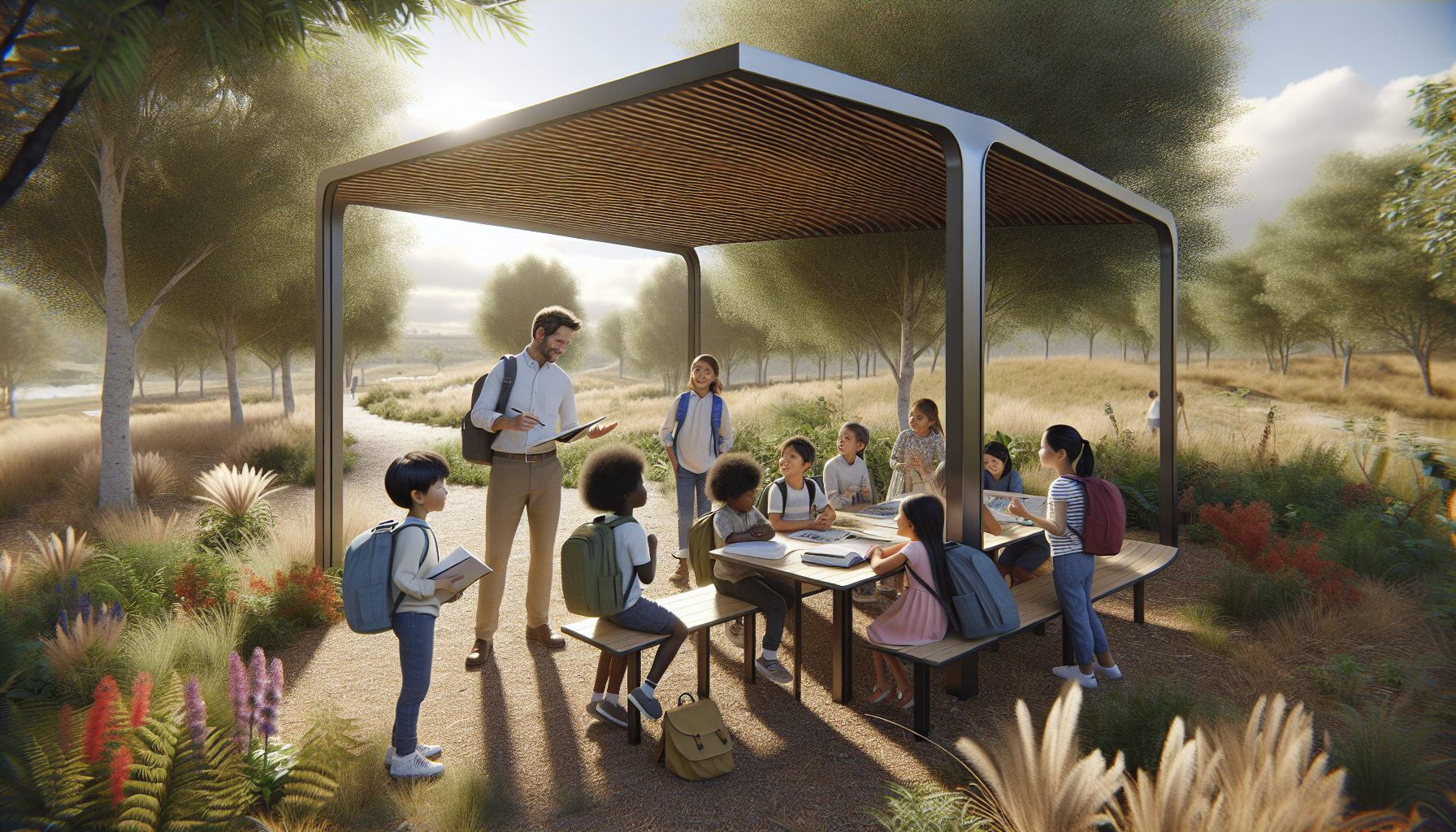In recent years, the concept of outdoor learning has gained considerable momentum, driven by a growing understanding of its numerous benefits for students of all ages. This innovative approach to education fosters a deeper connection with nature, enhances sensory experiences, and encourages a more active and engaging learning environment. However, as enticing as the idea of taking the classroom outside might be, there are practical challenges to consider, such as weather conditions that can disrupt or even deter outdoor activities. Enter the wind shelter teaching stations—an ingenious solution that not only addresses these challenges but also amplifies the advantages of outdoor learning. 🌿
Imagine a space where students can explore and interact with their environment while being shielded from the elements. Wind shelter teaching stations provide just that—an adaptable and protective outdoor learning area that ensures both comfort and engagement. These structures are designed to minimize the impact of wind and other weather conditions, creating an optimal environment for education without the distractions or discomforts that can accompany open-air classrooms. The result is an immersive learning experience that retains the flexibility of outdoor education while enhancing its effectiveness and accessibility.
As we delve into the world of wind shelter teaching stations, we will explore their numerous benefits in detail. From boosting student engagement and promoting physical well-being to supporting environmental sustainability, these innovative structures offer a multitude of advantages that can transform educational practices. We will examine how they encourage creativity and critical thinking, foster collaborative learning, and provide opportunities for hands-on, experiential education that is often lacking in traditional classroom settings. Additionally, we’ll discuss the role of these shelters in ensuring that outdoor learning can take place year-round, regardless of the weather.
The benefits of wind shelter teaching stations extend beyond the immediate educational environment. By integrating sustainable design principles and utilizing eco-friendly materials, these structures contribute positively to the environment. They serve as a practical demonstration of sustainable living, teaching students the importance of environmental stewardship and the impact of their choices on the planet. In doing so, they help cultivate a generation of environmentally conscious individuals who are better equipped to tackle the global challenges of tomorrow. 🌍
Join us as we uncover the transformative potential of wind shelter teaching stations in the realm of outdoor learning. Through insightful analysis and compelling examples, we’ll demonstrate how these structures can revolutionize the educational landscape, offering a harmonious blend of nature and nurture. Whether you’re an educator, a school administrator, or simply someone interested in innovative educational solutions, this exploration promises to be both enlightening and inspiring. So, let’s embark on this journey together and discover how staying engaged and protected in the great outdoors can redefine the way we teach and learn.
The Importance of Outdoor Learning Environments
Outdoor learning environments have become increasingly recognized for their ability to enhance education by connecting students with nature. These environments provide an enriching backdrop that promotes experiential learning, encouraging students to engage with the subject matter in a dynamic way. Learning outside the traditional classroom setting can stimulate the senses and ignite a curiosity that is often stifled indoors. 🌿
One of the primary benefits of outdoor learning is the opportunity for students to develop practical skills. This hands-on approach allows learners to experience real-world applications of their studies, making the education process more relevant and impactful. Furthermore, being outdoors can help improve mental health by reducing stress and anxiety levels, fostering a more positive attitude towards learning. Such benefits are invaluable in today’s fast-paced, often stressful educational environments.
Moreover, outdoor learning supports environmental stewardship. By spending time in nature, students develop a greater appreciation for the environment and a sense of responsibility towards its preservation. This connection can inspire future generations to adopt sustainable practices and advocate for environmental conservation. To maximize these benefits, it’s essential to have well-structured outdoor learning spaces that accommodate various weather conditions. This is where wind shelter teaching stations come into play.
What Are Wind Shelter Teaching Stations?
Wind shelter teaching stations are specially designed structures that provide a sheltered area for outdoor education. These stations are engineered to protect students and educators from wind and other adverse weather conditions, enabling learning to continue regardless of the environment. Typically constructed with durable materials, these shelters ensure safety and comfort, making them a viable solution for outdoor classes.
These teaching stations often feature modular designs that can be customized to fit the needs of different educational settings. They might include features such as transparent walls for visibility, flexible seating arrangements, and integrated technology for interactive learning experiences. With these structures, schools can utilize their outdoor spaces more effectively, expanding their classroom capacity and offering a variety of learning experiences.
Furthermore, wind shelter teaching stations encourage innovation in teaching methods. Educators can experiment with new pedagogical approaches that leverage the unique environment of the outdoors. From science experiments that require natural elements to art classes that draw inspiration from the surrounding landscape, the possibilities are endless. This adaptability makes wind shelter teaching stations a valuable asset in modern education.
Benefits of Wind Shelter Teaching Stations
Wind shelter teaching stations provide a multitude of benefits that enhance the educational experience for both students and teachers. One significant advantage is the improved focus and engagement from students. The novelty and openness of outdoor spaces can reenergize learners, making them more attentive and eager to participate in activities. Moreover, being surrounded by nature can inspire creativity and critical thinking, skills that are essential for problem-solving and innovation.
Another critical benefit is the improved physical health of students. Outdoor learning promotes physical activity, as students are more likely to move around and explore their surroundings compared to a traditional classroom setting. This physical engagement is crucial for developing motor skills and encouraging an active lifestyle. It also helps combat the sedentary habits that are common among children today.
Wind shelter teaching stations also offer logistical benefits. By utilizing these spaces, schools can reduce overcrowding in indoor classrooms, allowing for better social distancing and a more comfortable learning environment. This flexibility is particularly important in the wake of the COVID-19 pandemic, where maintaining safe distances has become a priority. For a closer look at how these stations operate, watch the video below by the ‘Outdoor Learning Channel’.
Comparing Traditional Classrooms and Wind Shelter Teaching Stations
| Aspect | Traditional Classroom | Wind Shelter Teaching Station |
|---|---|---|
| Environment | Controlled, indoor setting | Natural, outdoor setting |
| Engagement | Limited by four walls | Enhanced by nature and open space |
| Weather Impact | Unaffected | Protected from wind and adverse conditions |
| Physical Activity | Mostly sedentary | Encourages movement |
As you can see, wind shelter teaching stations offer a dynamic and engaging alternative to traditional classrooms, particularly when it comes to integrating physical activity and environmental interaction into the learning process. While traditional classrooms provide a stable environment, the advantages of outdoor settings can significantly enhance the educational experience.
Implementing Wind Shelter Teaching Stations in Schools
For schools considering the integration of wind shelter teaching stations, there are several steps involved in the process. First and foremost, it’s important to assess the available outdoor spaces to determine the best location for these structures. Considerations include the size of the space, the typical weather conditions, and the accessibility for students and staff.
Once a suitable location is identified, schools can explore different design options for their wind shelter teaching stations. These may vary in terms of size, materials, and additional features such as seating arrangements and technological integrations. Collaborating with architects or designers specialized in educational environments can help create a space that meets the specific needs of the school and its students.
Funding is another critical aspect to consider. Schools may seek grants or community partnerships to support the construction of wind shelter teaching stations. Demonstrating the potential educational and health benefits to stakeholders can help secure the necessary resources. Once established, these stations can serve as a valuable tool for enriching the curriculum and providing students with unique learning opportunities.
Maximizing the Potential of Wind Shelter Teaching Stations
To fully utilize wind shelter teaching stations, educators should consider incorporating a variety of teaching methods that leverage the unique advantages of outdoor learning. Here are some strategies to maximize the potential of these spaces:
- Integrate nature-based activities that encourage observation and exploration.
- Incorporate technology to facilitate interactive lessons and virtual field trips.
- Design cross-disciplinary projects that combine subjects like science, art, and physical education.
- Encourage student-led initiatives that promote leadership and teamwork.
By adopting these strategies, schools can create an engaging and comprehensive educational experience that extends beyond the confines of traditional classrooms. Wind shelter teaching stations offer a unique opportunity to connect students with their surroundings and inspire a lifelong love of learning.

Conclusion
In conclusion, the integration of wind shelter teaching stations into outdoor learning environments presents an innovative and practical solution to some of the key challenges faced by educators and students alike. Throughout this article, we have explored various dimensions of this concept, highlighting its potential to enhance educational experiences by making outdoor learning more feasible and effective. Let’s revisit the primary points discussed.
Firstly, we examined the increasing interest in outdoor learning and the benefits it offers, including improved student engagement, enhanced physical health, and a stronger connection to nature. Outdoor learning provides a dynamic environment where students can explore and interact with the natural world, fostering curiosity and critical thinking skills. However, weather conditions, particularly wind, can often be a barrier to maximizing these benefits. This is where wind shelter teaching stations come into play, providing a comfortable and controlled outdoor space that mitigates the impact of adverse weather while maintaining the open-air learning experience.
The structural design of these shelters was another focal point. Wind shelter teaching stations are typically constructed using durable materials that withstand various weather conditions, ensuring longevity and sustainability. They are strategically designed to offer protection from the wind without obstructing the natural beauty of the surroundings. This thoughtful design not only safeguards students and teachers but also enhances the aesthetic appeal of outdoor learning areas.
Moreover, we discussed the flexibility and adaptability of these teaching stations. They can be customized to fit different educational needs and environments, from small school gardens to expansive nature reserves. This adaptability makes them suitable for a range of subjects and activities, allowing educators to tailor their teaching methods to the outdoor setting.
Importantly, the implementation of wind shelter teaching stations also supports the development of essential life skills. Students learn to adapt to different environments and conditions, becoming more resilient and resourceful. This experiential learning approach encourages problem-solving and teamwork, skills that are invaluable in both academic and real-world contexts.
From a broader perspective, the use of wind shelter teaching stations aligns with sustainable and eco-friendly educational practices. By promoting outdoor learning, schools and institutions can reduce their carbon footprint and encourage environmentally responsible behavior among students. This commitment to sustainability is critical in today’s world, where environmental challenges demand innovative solutions and proactive engagement.
To further reinforce the significance of this topic, consider the implications of fostering a generation that is not only academically proficient but also environmentally conscious and adaptable to change. The integration of wind shelter teaching stations into educational settings is a step towards achieving this goal, providing students with the tools and experiences they need to thrive in a rapidly changing world.
As we conclude, it is essential to recognize the transformative potential of wind shelter teaching stations. They are more than just architectural additions; they are catalysts for change in the educational landscape. By embracing this innovation, educators can inspire a love for learning that transcends traditional classroom boundaries, fostering a more holistic and inclusive educational experience.
We invite you to reflect on how wind shelter teaching stations can be integrated into your educational practices or community spaces. Share your thoughts and experiences in the comments below, and feel free to spread the word by sharing this article with colleagues and friends who might find it insightful. Together, we can advocate for a future where outdoor learning is accessible, engaging, and protected from the elements 🌿.
For further exploration on the benefits and design considerations of wind shelter teaching stations, you can visit reliable sources such as Outdoor Learning Research or Eco-Friendly Educational Spaces. Let’s continue to explore and implement solutions that enhance our educational systems while nurturing a deep connection to the natural world.
Thank you for joining us on this journey to discover the benefits of wind shelter teaching stations. Your engagement and commitment to innovative education are what drive progress and inspire future generations.
Toni Santos is a visual storyteller and educational ethnographer whose work celebrates the fluid knowledge systems of nomadic cultures. Through art and research, Toni brings attention to how learning has thrived outside traditional institutions—rooted in movement, oral tradition, and deep connection to land and community.
Guided by a passion for ancestral wisdom, adaptive pedagogy, and cultural resilience, Toni explores the tools, rituals, and environments that once shaped the minds of travelers, herders, and migrating communities. Whether illustrating storytelling circles beneath open skies, wearable mnemonic devices, or maps woven into textiles, Toni’s work honors learning as a lived, sensory, and communal experience.
With a background in visual anthropology and intercultural design, Toni reconstructs the educational models of mobile societies through images and narratives that restore their dignity and relevance in today’s world.
As the creative mind behind Vizovex, Toni shares a rich tapestry of visual essays, artifact-inspired art, and curated stories that reveal the genius of teaching and learning on the move.
His work is a tribute to:
The wisdom of learning through journey, rhythm, and story
The spatial and environmental intelligence of nomadic cultures
The power of intergenerational knowledge passed outside walls
Whether you’re an educator, researcher, or lifelong learner, Toni invites you to step into a world where education is not confined, but carried—one step, one song, one shared insight at a time.





